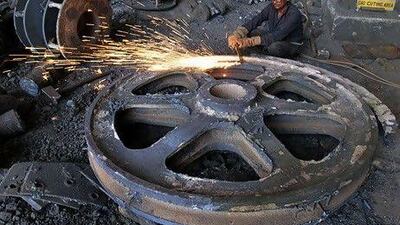Factories in China and India were until recently the last hope of a global economy on its kness.
The latest manufacturing data from both powerhouses shows, however, that even they are now grinding to a halt as demand from the West becomes weaker still.
The latest decline in output, as shown by purchasing managers' index (PMI) data released yesterday, suggests signs of stuttering production earlier in the year are starting to become more deeply entrenched.
Added together with high unemployment in the West and other economic challenges elsewhere, evidence of a global slowdown is starting to mount.
Policymakers in the euro zone and the United States are coming under pressure to strengthen their response to the turmoil, while counterparts in Asia are also increasingly anxious.
The latest PMI data will do little to ease their concerns.
In China, Asia's economic powerhouse, the manufacturing sector's operating conditions worsened at the sharpest rate in almost three-and-a-half years, according to the latest figures, for last month, from the HSBC Purchasing Managers' Index survey released yesterday.
"China's exporters are facing increasing difficulties amid stronger global headwinds," said Hongbin Qu, the chief economist for China at HSBC.
"China's manufacturing sector still faces intensifying downward pressure." This was only fuelling concerns that the slowdown in China's economy is deepening. "Beijing must step up policy easing to stabilise growth and foster job market conditions," said Mr Qu.
China's manufacturing economy declined to 47.6 last month, down from 49.3 in July, the bank's indicator showed. This came after official data released on Saturday revealed that the sector had contracted for the first time in nine months. A figure below 50 points to contraction, above that signals growth.
There is a similar story across other Asian economies.
Manufacturing production in India last month expanded at the slowest pace this year, according to data released yesterday by HSBC. This was partly because parts of the country recently suffered major power outages that left hundreds of millions of people in the country without electricity.
"The momentum in the manufacturing sector eased further on the back of weak external demand and output disruptions caused by the major power failures," said Leif Eskesen, the chief economist for the India and Asean region at HSBC. "The power failures also partly contributed to a rise in backlogs of work as manufacturing companies struggled to finish orders on time."
New export orders were also affected by weaker international demand, the data showed. A worsening outlook for the euro zone has been one of the factors affecting India's performance. Several economists have lowered their economic growth forecasts for India.
The euro zone's economy is expected to shrink by 0.6 per cent this year compared with a previous forecast of zero growth, according to a revised forecast from Standard & Poor's.
The euro zone accounts for 15 per cent of India's total exports, according to Crisil, a ratings and research company based in India.
"In recent months, the manufacturing sector has been hit by slowing investment demand and contraction in merchandise exports," economists at Crisil said in their latest report. Growth in domestic demand had also moderated, they added.
Elsewhere in Asia, HSBC's PMI for South Korea was at 47.5 last month following a reading of 47.2 in July, "pointing to a further deterioration in the health of the South Korean manufacturing sector", HSBC said. Similarly, data on Taiwan also showed weakness in the sector.
In Europe, the source of much of the global woes, the situation was little better. Output across the 17-country euro zone slipped last month, according to Markit, which produces the survey in the single currency area. Despite factories cutting prices, the region's manufacturing sector still shrank. The overall PMI was 45.1, above July's three-year low of 44.
Data for the euro zone's powerhouses of Germany and France also provided little cheer.
Germany's manufacturing PMI rose to 44.7 last month, up from a 37-month low of 43 in July.
Output, new orders and employment all dropped at slower rates. But the overall reading was still below the 50 mark separating growth from contraction.
Worryingly, German export orders, often a forerunner for future performance, slipped at the fastest rate since April 2009.
Survey respondents commented on a general slowdown in global demand and particular weakness in new-business inflows from southern Europe.
France's reading was also weak at 46. Italy and Spain's readings have been below 50 for more than a year. Only Ireland reported a rise in manufacturing output. Irish manufacturing decelerated to 50.9 last month from 53.9 the month before, but the figure still represented growth.
Despite the shaky global backdrop, economies in other parts of the world also managed to record growth.
Expansion in business activity helped to increase Saudi Arabia's reading to 58.31, up from a seven-month low in July.
Russia's PMI fell to 51 last month, from 52 the month before.

